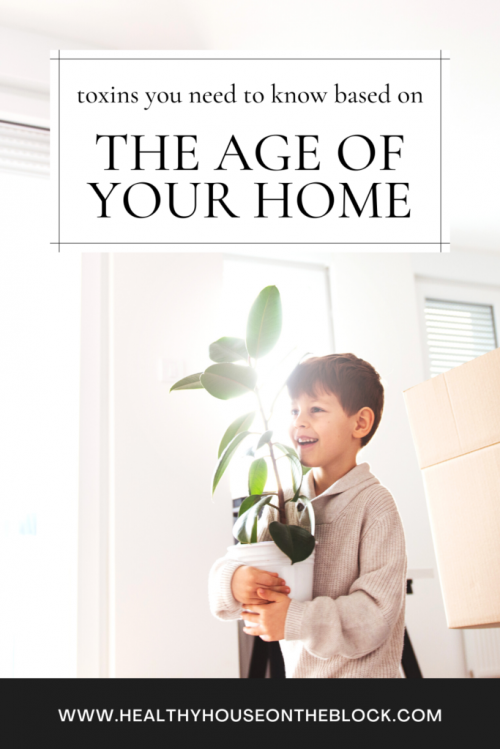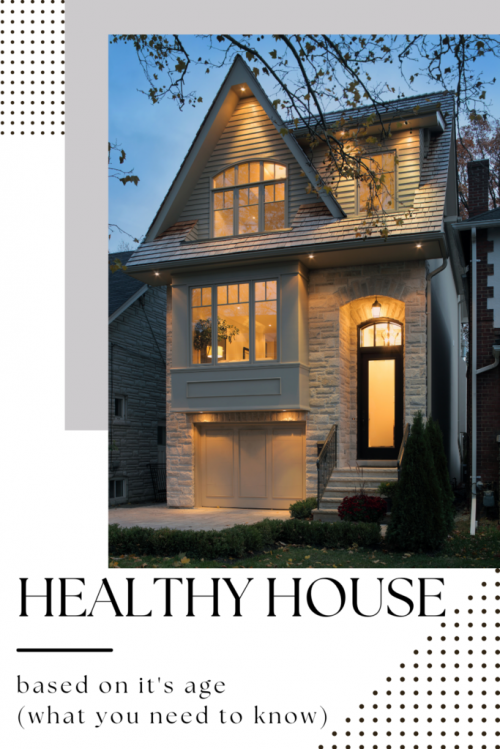
One size fits all solutions for homes really isn’t a thing. It’s the reason why so often getting someone else’s eyes on your own home is the best case scenario when you’re trying to correct a problem or change things in a positive direction. Old homes and new homes will have some of the same overlapping toxins present, but they will also have their own toxins that came with the era they were built in.
As a certified home inspector in Minnesota, I’ve had the pleasure of inspecting everything from brand new builds to 1880 farm houses. Creating a healthy home environment in different style homes and homes that were built in different decades is a task that has to be curated to that specific house. Just like the reason for a doctor’s visit is for them to look at YOU and tailor-fit a plan for your health and wellness. Just as our bodies are all unique and different, so are the homes we live in.
Based on your home’s age, I’m going to share with you the specific toxins you can reduce as well as the exact concerns you need to be aware of due to when your home was built. It’s another marker if you will that will inform you of the health and wellness of your space.
Remember that no home is completely toxin free and all homes will have some level of unhealthy materials or components. And the truth of the matter is — this is okay to some extent. As long as you’re aware of the problems and do your best to mitigate toxins where you have control over them, your home will be healthier than most, guaranteed.
TOXINS THAT WILL OVERLAP EACH ERA OF HOME
In each era of home, there will be toxins that overlap, based on our lifestyles and some problems have just never been eradicated over time. Whether you’re in an old home or a new home, some toxins will just be problematic and must be addressed.
VOCs: Volatile Organic Compounds are everywhere. They’re naturally present in nature and outdoors beside being inside our homes. The difference is, our homes don’t allow VOCs to escape once they’ve been off gassed into our air. Without a place to go, VOCs build up to an unhealthy level, which in turn affects our bodies’ in a multitude of ways.
VOCs have been linked to liver damage and kidney damage, nerve damage, neurological effects as well as have been labeled as carcinogenic. VOC exposure is inevitable, but there are ways we can reduce exposure within our home. This post contains really in depth information on VOCs inside your space and how to minimize them around your home.
Mold: Every home, new or old home has the potential for mold and mildew growth due to a variety of factors. The biggest contributor, though, is likely our habits and inability to keep our homes dry. Mold is a dangerous toxin that should not be taken lightly. Any area of mold in your home has the potential to cause allergic response, infection and dangerous mycotoxin exposure. Be on the lookout for mold in your own home and be diligent about keeping indoor humidity levels low. This post will give you some helpful tips on keeping mold out of your home.
Carbon Monoxide: All homes that use natural gas have the potential for toxic carbon monoxide inside their homes. It is a silent killer as it is odorless and we often have no idea of it’s presence inside the home. Carbon monoxide has also been shown to have negative effects when exposure at low but constant levels happens.
Keeping carbon monoxide detectors on each level of your home and especially outside of sleeping areas is extremely important. Any gas appliance (stove, fireplace, furnace, water heater, dryer, etc) has the potential for back drafting carbon monoxide into your home.
Radon: While some professionals will tell you that it’s the old homes that have higher radon levels, this just really isn’t the case. Radon can be present and present at high levels in new homes as well, even if they have an indoor air exchanger. The difference in some new homes is that they actually have passive radon mitigation systems that reduce levels of high radon inside. But even if your home is extremely sealed, you can actually pull radon inside from floor drains and miniscule cracks due to negative air pressure. All homes should be tested for radon in my opinion as a Radon Testing Professional and Home Inspector.
Radon is the number one cause of lung cancer in non-smokers and can be extremely damaging to those living or spending large amounts of time in the lowest levels of their homes. This post will give you options to manage radon in your own home.

THE OLD HOME (1880s - 1930s)
Asbestos: Asbestos is present in flooring, ceiling tiles, popcorn ceilings and even some drywall. Asbestos is a cancer causing material (STUDY) and has been linked to lung cancer and abdominal cancer as well as mesothelioma (STUDY). Generally, asbestos becomes the greatest health hazard when it is disturbed. This will allow the particles to enter the air and make their way into dust and particles around the house. When inhaled, there can be serious health implications, and so it’s definitely a toxin to be aware of in your home.
Lead: Lead was widely used in paint and pipes in older homes. If you’re buying an old house built before 1978, there’s potential that you have some lead paint in the home. Now, lead paint, undisturbed and free of chips is no problem at all. Once it starts to chip, the dust can become an issue with members of the home inhaling the particles.
Lead exposure is a problem in terms of health, especially in children, where it can build up to poisoning levels and affect learning and behavior. (LEAD EXPOSURE STUDY).
Old homes are a unique type of home to care for and you can learn all about the specific benefits they offer to a healthy home space in this blog post.

THE MAN-MADE HOME (1940s - 1970s)
Lead and asbestos are likely an overlapping toxin in this era of homes as well.
PCB Electrical Insulation: Polychlorinated biphenyl is a toxin that before 1979 was used in electrical writing insulation as well as fluorescent light ballasts. It’s an odorless chemical that has adverse effects on the immune system, hormone production, nervous system and reproductive system. An electrician will be able to identify and check the condition of PCD line or insulated wiring in older homes for you. And if they detect rotting wire insulation, you’ll want to have it replaced in your home.
PVC Toxins: When materials like man made vinyl flooring and plastic components began showing up in homes, PVC toxins became a health concern. Carpet backing, flooring and any sort of vinyl being added to homes likely contains PVC toxins (polyvinyl chloride).
Polyvinyl chloride is a big health concern for kids, especially when it comes to flooring as most children spend more time in close proximity to the floor. PVC toxins have been shown to disrupt natural development of children and have been linked to childhood obesity. (STUDY) PVC toxins are a hormone disrupting toxin, which can ultimately increase the risk of cancer. (Study)
Formaldehyde: Somewhere in the middle of this era of old homes, toxic plywood began being used and wood veneer became increasingly popular. It was less expensive and appeared to be easier to install and manufacture than solid wood. Unfortunately any wood glue that was used in this period most definitely contained formaldehyde and an array of VOCs. These toxins off gas forever and are likely very present in cabinets, plywood subfloor and laminate countertops.

THE ENERGY EFFICIENT HOME (1980s - 2000s)
Polyvinyl chloride and formaldehyde are still overlapping toxins in this era of home.
Flame Retardants: Flame retardants used in carpeting, drywall and other building materials throughout the home have been showing up in dust particles around our homes. Flame retardants in our environments have been linked to thyroid issues, infertility and learning disorders. Many of our newer products are naturally flame resistant and don’t require as many chemicals added to our building materials to make them flame retardant.
Carpet Toxins: Carpeting contains some of the WORST toxins we bring into our home. This is the case for several reasons. NOt only does carpet contain toxins like phthalates, flame retardants, VOCs and formaldehyde, but the surface area is so vast in our homes that the toxins are EVERYWHERE. And carpet has the tendency to create a lot of dust that will contain these toxins, meaning it’s everywhere in our homes including our air.
Formaldehyde: Formaldehyde is a VOC that is a known carcinogen and disrupts the endocrine system’s regulation of our hormones. Formaldehyde is found in everything from carpet to building adhesives and pressed woods around our homes. It’s
Sulfide Gasses: Imported drywall during the early 2000s has been found to emit sulfide gasses that can cause an odor within the home. These sulfide gasses will eventually corrode copper within the home (water pipes, HVAC units, gas lines and electrical components). The biggest telltale sign is the odor present that just won’t go away in a home, but you can also check to see if copper is severely corroded around the home.

THE NEW HOME (2010 - PRESENT)
Formaldehyde and PVC toxins are also likely very present in these era homes.
Phthalates: Phthalates are sometimes referred to as plasticizers, and it’s a grouping of chemicals that we are exposed to almost constantly. Homes that have many plastic and vinyl components are the homes that contain high levels of this toxin. Phthalates show up in our blinds, wallpaper, plastic water pipes for drinking water and vinyl flooring.
Phthalate exposure has been linked to abnormal reproductive development as well as neurological toxicity in kids and adults. (STUDY) Some phthalates are also known endocrine disruptors, meaning they hinder our natural hormone production and can in turn cause issues with thyroids, immune system and the reproductive process (STUDY).
Isocyanates: New homes most often contain spray foam insulation to make them extremely energy efficient. Spray foam insulation typically includes isocyanate and polyol in addition to flame retardants to make it “safer” for our new homes. If spray foam is not properly applied in the home, there could be increased exposure to these chemicals after the home is completely finished. Isocyanates are an endocrine disruptor and have been linked to an increased risk of cancer.
MDI: This mixture of toxins includes ingredients such as benzene, chlorine compounds and formaldehyde and is often found in spray foam insulation. The interesting and scary part of this particular toxin group is that it has been shown to lead to the development of chemical sensitivities in the future. It’s basically a catalyst for things like asthma, allergies and becoming sensitive to other chemicals. (Spray Foam Insulation Information)
Few Air Exchanges: One of the most dangerous things about new homes is their inability to bring in fresh air and exchange toxic air inside. The idea of an air exchanger is supposed to help with this issue, and many new homes have these systems, however it’s up to the homeowner to use them and keep the filters clear so they don’t have the opposite effect on the indoor air.
An energy efficient home is great for cost and sustainability, however, you have to consider that these homes are also causing issues by keeping toxins inside, where they build up to unhealthy levels.
Toxins at home, whether a new home or an old home are going to be unavoidable. That being said, there’s no use worrying or stressing about these toxins. It’s better to be aware of their presence and then take some actionable steps to reduce the levels of toxins around your home. Even some small changes or swaps can have a huge impact on your space and your health.



